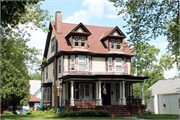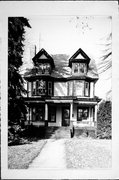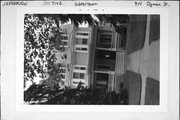Property Record
914 Clyman St.
Architecture and History Inventory
| Historic Name: | Charles & Elizabeth Kading House |
|---|---|
| Other Name: | |
| Contributing: | Yes |
| Reference Number: | 7142 |
| Location (Address): | 914 Clyman St. |
|---|---|
| County: | Jefferson |
| City: | Watertown |
| Township/Village: | |
| Unincorporated Community: | |
| Town: | |
| Range: | |
| Direction: | |
| Section: | |
| Quarter Section: | |
| Quarter/Quarter Section: |
| Year Built: | 1912 |
|---|---|
| Additions: | |
| Survey Date: | 1986 |
| Historic Use: | house |
| Architectural Style: | Colonial Revival/Georgian Revival |
| Structural System: | |
| Wall Material: | Clapboard |
| Architect: | |
| Other Buildings On Site: | |
| Demolished?: | No |
| Demolished Date: |
| National/State Register Listing Name: | Clyman Street Historic District |
|---|---|
| National Register Listing Date: | 8/3/2015 |
| State Register Listing Date: | 2/27/2015 |
| National Register Multiple Property Name: |
| Additional Information: | This was the home of Charles and Elizabeth Kading, two prominent twentieth century attorneys. Charles Kading grew up on a farm in Dodge County. He attended the University of Wisconsin-Madison and became the assistant principal of the graded schools at Theresa in Dodge County. Elizabeth Holste, a graduate of Watertown High School, was teaching school at Theresa when she met Kading. They both decided to attend law school at Valparaiso University and graduated in the class of 1900. They married in that year and came to Watertown where they set up the law practice of Kading and Kading. Both Elizabeth and Charles Kading were active attorneys. Although after the birth of her son in 1907, Elizabeth Kading became more of an office counsel, though she became active in state government, serving as President of the State Civil Service Commission and the State Board of Control. Charles Kading was active in many organizations in Watertown and was one of Watertown's progressive mayors, serving from 1916-1920. Tragically, Elizabeth Kading died in an auto accident in 1925. Charles Kading continued to lived in this house and, a supporter of Robert M. LaFollette, he was elected as a Republican to congress for three terms between 1927 and 1933. Charles Kading continued to practice law with his son until his death in 1956. The Kadings' long-term offices were located in the Masonic Temple. This house is significant because it was associated with Charles and Elizabeth Kading. Elizabeth and Charles Kading were typical of the middle class professionals who became prominent in law and politics during the early years of the twentieth century. Charles Kading was a supporter of the park system, improvements in government services, and non-partisanship in local government when he was a local official. He was a congressman in the camp of Robert M. LaFollette during his national government service. Progressive women during this era were involved in promoting social welfare issues related to the schools, public health, and governmental reform. They usually promoted these issues through club membership or other "women's" organizations. Elizabeth Kading took a more male-oriented route in her career, becoming an attorney and remaining actively involved in her profession even after her son was born, an unusual occurrence in this era. Her career peaked during her service at the state level on the Civil Service Board and the Board of Control. The Kadings workplace was in the Masonic Temple making that building the most significant resource associated with their careers. This house has some historical interest as their home, although they did live at two ther locations before this one. However, Charles Kading continued to live here long after the death of his wife. Distinguished by a pair of pedimented gable roofed dormers placed above a pair of three-sided second story bay windows, this frame house is characterized further by an open porch with balustrade and Ionic columns placed on paneled bases. A rectangular east bay window, leaded glass windows, and shingled gable ends added to the irregularity of this Queen Anne influenced house. A one-story addition is located at the rear. One of the relatively few buildings in the city exhibiting the influence of the Queen Anne style, this house has retained a good degree of architectural integrity. |
|---|---|
| Bibliographic References: | (A) Watertown City Directories, 1866-1930, Watertown, Wisconsin Public Library. (B) Dictionary of Wisconsin Biography, Madison: State Historical Society of Wisconsin, 1960, p. 199. (C) John H. Ott, Ed., Jefferson County Wisconsin and Its People, Chicago: S.J. Clarke Publishing Co., 1917, pp. 70-72. |
| Wisconsin Architecture and History Inventory, State Historic Preservation Office, Wisconsin Historical Society, Madison, Wisconsin |




